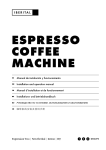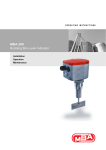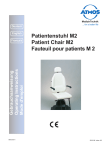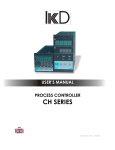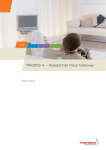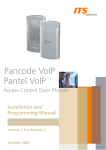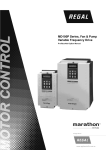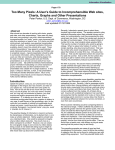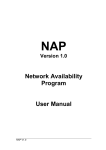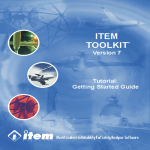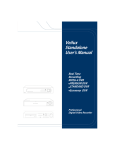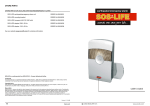Download User`s Manual RizEx2
Transcript
Scientific Center Of Risk Investigations “Rizikon”
USER’S MANUAL
(FUNCTIONAL DESCRIPTION)
OF THE RESEARCH SOFTWARE COMPLEX OF RISK ASSESSMENT
AND ACCIDENT SIMULATION “RizEx-2”
Severodonetsk, 2011
Contents
1. PURPOSE OF APPLICATION ......................................................................................................... 3 2. STRUCTURE OF THE COMPLEX ................................................................................................. 4 3. FUNCTIONAL DESCRIPTION OF THE SYSTEM....................................................................... 6 3.1 Functional description of the modules that comprise block "Risk" of "RizEx-2."software. ...... 6 3.1.1 Module "Reliability Database" ................................................................................................... 6 3.1.2 Module "Fault tree" .................................................................................................................... 8 3.1.3 Module "Events tree" ............................................................................................................... 12 3.2 Description of the modules block "Formation" of the research complex "RizEx-2". ................ 17 3.2.1 Module "Gas outflow".............................................................................................................. 17 3.2.2 Module "Liquid outflow" ......................................................................................................... 20 3.2.3 Module "Evaporation".............................................................................................................. 22 3.2.4 Module "Total flow" ................................................................................................................ 23 3.2.5 Module "Formation of explosion-hazardous cloud". ............................................................... 24 3.2.6 Module "Accident". .................................................................................................................. 26 3.3 Description of the modules block "Risk" research complex "RizEx-2"..................................... 31 3.3.1 Module "Explosion. Calculation by empirical relationships" .................................................. 31 3.3.2 Module "Fragments" ................................................................................................................ 33 3.3.3 Module "Fire. Calculation by empirical relationships". ........................................................... 38 3.3.4 Module "Fire 3D-model".......................................................................................................... 41 3.3.5 Module "Torch"........................................................................................................................ 42 3.3.6 Module "Dispersion. Gaussian model. Neutral gas" ................................................................ 43 3.4 Module "Events tree" and modules block "Accident"................................................................ 47 3.5 Module "Risk" ............................................................................................................................ 50 3.6 Block "Service" .......................................................................................................................... 53 4. SYSTEM REQUIREMENTS ............................................................................................................. 54 5. USER ADVICE AND CUSTOMER SERVICE ................................................................................ 54 6. DELIVERY OF THE COMPUTER SOFTWARES TO THE CLIENTS ..................................... 55 7. LICENSE CONFIGURATION FOR ONE SET OF INSTALLATION PACKAGE OF THE
"RizEx-2" SOFTWARE AND THE CONDITIONS OF PURCHASE............................................... 56 8. Installtion and setup of software complex. ........................................................................................ 57 2
1. PURPOSE OF APPLICATION
International and national legislations regulate the conduct of risk and hazard analysis at all
stages of the life cycle of complex technological objects, such as chemical-engineering systems,
power systems, pipeline transportation of hazardous products, aircrafts, vessels and other means of
water transportation, steel factories etc.
Some objects (eg, chemical plants) can be comprised of tens of subdivisions. Each structural unit
may have hundreds or even thousands of apparatuses with hazardous substances, many units of
valves and control devices, and complex control systems. Managing these systems requires a lot of
manpower.
To assess the risk of such complex systems and determine their sufficient safety requires a
simultaneous analysis of the vast array of information. It involves creating many models of random
and deterministic processes, comparison and analysis of simulation results and numerous
calculations
and
making
a
number
of
decisions
on
risk
reduction.
To perform such an analysis correctly without modern information technology is virtually
impossible.
Scientific Center of Risk Investigation "Rizikon" has developed the investigative program
software for modeling complex industrial accidents and risk assessment called "RizEx-2". This
software can be applied to perform all procedures for hazard analysis and risk assessment that are
governed by applicable international and national laws, regulations and standards. The complex
makes it possible for expert organizations and engineering personnel of industrial enterprises to
carry out work related to risk analysis to perform necessary safety measures, as well as for
preparation of project documentations and records associated with the operation of hazardous
industries. The program can be used to perform the following tasks:
development of the declaration of industrial, fire and environmental safety of hazardous
production facilities;
assist in the decision making on the choice of electrical, electronic, programmable, and
other systems to be used to perform safety functions during design of structurally complex
technological systems;
development of safety procedures to localize and eliminate emergency situations;
development of safety procedures to prevent and eliminate accidental spills of crude oil
and petroleum products;
development of material safety data sheets of hazardous objects;
calculation of optimal rates for insurance of industrial facilities;
investigation of accidents and insurance claims;
development and implementation of company policy on risk management;
development and implementation of other engineering solutions on risk management.
3
2. STRUCTURE OF THE COMPLEX
The complex has a modular structure that allows the user to upgrade certain sections without
updating or acquiring the whole new version of the program.
The modules are grouped into the following sections:
1. Block "Formation", which consists of modules that perform simulation of physical
processes of emission of hazardous substances from the emergency site and the development of the
following emergency situations: "Gas outflow", "Liquid outflow", "Evaporation", "Total
flow", "Formation of explosive-hazardous cloud".
2. Block "Accident", which consists of modules that perform simulation of emergency
processes taking into account changes in accident affecting factors in time and space, and
determination of consequences of an accident and their conditional probabilities: "Explosion.
Calculation by empirical relationships", "Fragments", "Fire. Calculation by empirical
relationships", "Torch", "Fire. 3D-model", "Dispersion. Gaussian model. Neutral gas".
3. Block "Risk", which consists of modules that perform a comprehensive assessment and
risk analysis for an industrial facility, "Reliability database", "Fault tree", "Events tree",
"Accidents", "Risk".
4. Block "Service" includes the following modules: "Data base of hazardous substance
properties", "Graphic editor", "View results".
Figure 1 shows structural scheme of the working complex.
Figure 1. Structural scheme of the organization of hazard analysis process and risk assessment by
the software complex "RizEx-2».
The structure of the software complex "RizEx-2" takes into account that any emergency process
(explosion, fire, toxic cloud, etc.) are the result of random processes of failures in the “MachineMan” system that lead to an accident.
Modeling of the random process of the accident occurrence is performed by using the module
"Fault tree". It determines conditions of the leakage of hazardous substance out of closed
technological system when its integrity is compromised. Probabilities of failures for the basic events
in the "Fault tree" model are contained in the reliability database.
4
The development of the accident, which ultimately leads to its occurrence, has many
directions, each of which is determined by a set of failures and containment measures including
human actions. Modeling of the random process of the accident is performed using the module
"Events tree". It finds the concluding states, which determines the conditions of development and
scale of the accident.
The modules “Formation” and “Accidents” determine the possible types of emergency
events (i.e. fireball, flame, explosion cloud, flash etc.) depending on the properties of hazardous
substances, time of appearance of the source and developing conditions specified in each final state
of "events tree". They calculate the probability of emergency events (i.e. explosion, fire, toxic
cloud, etc.) and the parameters that determine the scale of possible consequences.
Module "Accident" defines the spatial distribution of the harming factors during the
accidents and determines the probability of their impact on people, property and the environment.
Module “Risk” is used to determine total territorial, individual and social risks and to plot FN diagram for many elements of technological systems (machines, technological complexes, etc.)
for each of which different accident initiating events of various scales can be implemented.
5
3. FUNCTIONAL DESCRIPTION OF THE SYSTEM
3.1 Functional description of the modules that comprise block "Risk" of "RizEx-2» software.
3.1.1
Module "Reliability Database"
The database contains data on failures and failure-free operation of about 3000 elements of
technological systems and has 4 sections: equipment, armature and pipelines, measuring
instruments and automation systems, emergency protection systems (Fig. 2a). Each section has 6 to
11 subsections (Fig. 2b).
a
b
Figure 2. Search of a type (a) and subtype (b) of the system element to determine the
probability of failure.
You can search the database by name of the element (see Figure 3).
6
Figure 3. Search database by name of the element.
In addition, the database contains the data on the erroneous actions of the staff members based
on their duties and taking into account time of the shifts, functional activities, operation in normal
and stressful situations.
The database contains the data obtained from statistical information on the operational
reliability of individual industries as well as the data collected from the scientific and technical
literature, the regulatory and technical documentation.
If some element contains the information on its reliability from different sources, it is possible
to determine mean values of reliability parameters (Fig. 4).
Figure 4. Calculation of the reliability parameters on data collected from different sources.
The database allows the processing of new information about failures, collected during
operation.
The database is continuously updated.
Information in the database on failure probabilities is used as initial information about the
probability of basic (elementary) events in the "fault tree" to calculate the probability of
intermediate and final events of "fault trees" and "events trees" during their analysis.
7
3.1.2
Module "Fault tree"
This module is designed to analyze a random process of accident initiation as a result of
accumulation of failures within a technological system and human errors based on the graphical
representation of logical and probabilistic schemes.
"Fault tree" is built from the top down (from the top to the roots), by setting (identifying) the
cause-effect relationships between hazardous events and failures that lead to such events.
To construct a "fault tree" in a graphical form conventional graphic symbols of its elements
and the logical symbols stipulated by existing standards are used.
The logical connections combine the events according to their causal relationships. The
logical connections are indicated by the tags shown in Figure 5:
- Sign of a logical link between "AND" events. Output event occurs if all
input events occur at the same time.
- Sign of a logical link between "OR" events. Output event occurs if any (at
least one) of the input event occurs.
- Sign of a logical link between "XOR" events. Output event occurs if only
one of the connected events takes place.
- Sign "Inhibit". Output event occurs only if in conjunction with other input
events the conditional event occurs.
Events are divided into four types:
- A "Compound event" is the result of the implementation of one or more
events (simple or compound), that are united by logical connections "AND"
"OR", "Inhibit", "XOR".
- A “Simple event" is a source of influence onto the system and is
characterized by the probability of occurrence (implementation).
- An "Undeveloped event" is a compound event with known probability,
which is obtained from external sources. Its function is similar to simple
event.
8
- A "Developed elsewhere event" is an event with probability determined by
the events tree, created in another file.
Figure 5. Logical symbols and graphic elements used to build the "fault tree".
The module allows to select based on hazard analysis of the initiating accident event to
conduct automated construction of "fault trees" in an ordered graphical (Fig. 6a) or text (fig. 6b)
representation of the logical-probabilistic connection of random events (violations, failures,
errors. etc.) that leads to the implementation of the unwanted final event.
Figure 6. Fault tree leading to the destruction of the column in the graphic (a) and text (b)
representation.
The probability of the basic (elementary) events in the fault tree can be obtained from
reference sources, it can be determined based on the statistical data presented in technical literature
or based on statistical data obtained during the operation (operational reliability), or from the
database of "RizEx-2" software. If the probability values of failure for basic events are known the
program when you select the "probability" calculates the probability of intermediate and upper level
(initiating) events. If the uncertainty of the probability values is known (confidence interval at a
given confidence probability), the program calculates the uncertainty of the accident initiating
event.
9
Figure 7. Determining events probabilities in the fault tree, taking into account the accuracy
of determining the probability of elementary events at a confidence level 0.9 (the uncertainty
analysis for risk assessment).
To construct "fault tree" the probability of "minimum emergency combinations" and the
"minimum passing combinations" are automatically detected and ranked based on the probability of
occurrence (Fig. 8).
Figure 8. "Lowest emergency combination" in the fault tree that lead to the destruction of
waste incineration of organochlorine reactor (204-th minimum emergency combination out of 220
possible combinations).
The program allows for restrictive "minimum emergency combinations" that has the highest
probability of implementation to search for solutions to reduce the probability of the "upper" event
in the "fault tree" (Fig. 9).
10
Figure 9. Reducing the probability of failure of the waste incineration of organochlorine
reactor based on analysis of " minimum emergency combinations" in the fault tree. The probability
of the reactor destruction before (a) and after (b) optimization.
Similarly, solutions can be found to reduce the probability of emergency triggering events
based on accident analysis of “passing combinations».
The following methods of automated analysis of significance of basic events can be used to
find solutions and reduce the cost of security systems:
Birnbaum method;
RRR - Risk Reduction Ratio;
RRI - Risk Reduction Interval;
RIR - Risk Increase Ratio;
RRI - Risk Increase Interval;
Fussell-Vesely method;
CIM-Criticality Importance Measure.
Because fault tree of complex technological systems with a large number of elements has a
large size, the program makes its automatic "cut" with a graphical representation on the required
number of pages printed in a subsequent report (fig.11).
11
Figure 10. Analysis of the degree of influence (importance) of basic events in the "fault tree"
on the change in the probability of system failure.
Figure 11. Cutting and printing of "fault tree" in the report.
3.1.3
Module "Events tree"
This module is designed for the analysis of a random process of accident development,
including the identification of possible directions of accident development and the conditions of
formation of accidents that are caused by triggering or failure of protection systems based on
graphical representation of logical and probabilistic schemes.
The module allows for the top (accident initiating) event in the "fault tree" to automatically
build an "events tree", by considering the possible consequences of activation and failure of safety
systems and personnel errors in response to new and developing accident.
12
From the time accident initiating event occurs all the events of triggering or failure of safety
systems and error-free or erroneous personnel actions are considered consequently as they take
place.
Events tree is built based on the dependence of events from each other (fig.12).
a
b
Figure 12. Independent events A and B (a) and dependent events, when event B takes place
only under condition that event A does not occur (b).
If there are events that depend on event A and event B that are also dependent on each other,
then this dependence is set by the user separately. To do so, from the list of events in the fault tree,
select the event that is dependent on other events and select the condition at which this event occurs
(Fig. 13).
Figure 13. Setting the conditions of dependence between the events in the "events tree".
When a safety system is selected, the probability of its failure and its reaction time are
indicated. Other parameters that determine the efficiency of safety system such as the response time
of the shut-off device, the output of the emergency pump, flow intensity when discharged into drain
tank, etc. (Fig. 14).
13
If for a complex safety system the probability of failure is unknown, it can be defined by
building "fault tree", using appropriate software modules of the "RizEx-2" complex.
Figure 14. Probability and efficiency of the selected safety system.
The program allows to take into account the stress state of a person while determining the
likelihood of human errors at the beginning of the accident and the changes in the probability of
erroneous actions in time, considering time necessary to assess the situation and make the decision
(Fig. 15).
a
b
Figure 15. The probability of erroneous actions by a staff member after 1minut (a) and after
25 minutes (b) of receiving information about an emergency situation.
Analysis of the relationships between safety systems and accident deterring systems
determines the set of final states with a certain probability of each final state (Fig. 16). In addition,
each final state, along with conditions of release, as defined in the initial event (top event of a fault
tree) determine the possible scope of consequences on the given set of actions and failures of safety
systems and accident deterring systems.
14
Figure 16. Identification of possible final states of accidents in a given set of security systems
by the "events tree" method.
The program allows you to define how the conditional probability of each final state, provided
that the accident initiating event occurred, and the absolute (Fig. 17).
Figure 17. Determination of the probability of the final states on the condition that triggers the
initial crash event has occurred (a), and the unconditional probability of the final states (b).
Due to the fact that a large number of systems, security, and possibly very large number of
combinations of response and failure and, consequently, different effects, it is possible to optimize
the results and the final selection of events that should be sufficient for proper risk assessment.
The program allows the set of possible final states fulfill the condition of minimization of the
definition of the total probability of events with the same scale of possible consequences (Fig. 18).
15
Figure 18. Reduction of the number of final states considered the minimization of "events
tree" on the condition.
Because of the possible final states in the “events tree” are events with obviously negligibly
low probability, then the set limit on the probability of the final states are used to calculate the
integral indicators of risk (Figure 19).
Figure 19. Reducing the number of final states considered the minimization of "events tree" in
probability.
For each set of alarms and security systems failures in the "events tree", according to their
performance, time to detection of the arisen situation, decision-making and response personnel
determined by the total time on the formation of an emergency in the final event.
The program allows you to draw a graphical representation of "events tree" with its listing in
the report (Figure 20).
16
Thus, as a result of the random process modeling and development of methods of accident
"fault tree" and "events tree", the probability of each set of final states, conditions, and time for the
formation of an emergency.
Figure 20. Cutting and printing "events tree" in the report.
3.2 Description of the modules block "Formation" of the research complex "RizEx-2".
3.2.1
Module "Gas outflow".
This module is designed for determining the input of hazardous substances into the
environment during depressurization apparatus and / or pipes with compressed gases. Outflow
simulated with the input of hazardous substances in an emergency unit from the adjacent units to
overlap flows.
If the initiating event of an accident is the formation of emergency openings in the unit, then
selected tab "through opening" (Fig. 21). You must set the parameters of the openings and set the
alarm time, the overlap of adjacent to gas apparatus for forward and reverse flows.
17
Figure 21. Simulation of the emergency gas flow through the opening.
If the initiating event of an accident is a break after the pipeline system, then choose tab
"through the pipeline system," and further defined diameter, length and roughness of the pipe, and
the coefficients of local resistance (Fig. 22).
Figure 22. Simulation of gas flow through the emergency system of pipes.
If the initiating event leading to the accident pipeline breakages, supplied to the unit under
consideration (the complete destruction of the device), then on the expiry of each flow is considered
using a bookmark "through the pipeline system".
The program allows you to get graphs of the intensity of gas outflow from accidental
openings and the average intensity of the expiration time, the intensity of the receipt of gas in the
emergency unit of the adjacent units, pressure in the emergency unit and the mass ejection at the
expiration time for the analysis of process emissions (Figure 23).
18
Figure 23. Obtained by the calculation results change over time the mass flow rate (a), pressure (b)
and mass ejection (c) of gas when the formation of an emergency openings.
The module allows you to get background information on the source intensity to simulate the
dispersion of hazardous substances into the atmosphere. The module creates a text report in html,
including graphs obtained dependences of the parameters of discharge (Fig. 24).
The fragment of the report on the results of simulating the gas outflow.
19
3.2.2
Module "Liquid outflow"
This module is designed for determining the intensity of the outflow of hazardous substances
into the environment during depressurization of apparatus and/or pipelines with fluids or liquefied
gases.
Calculations can be made for vertical cylindrical devices, for horizontal cylindrical devices
and devices with conical and spherical shape. If the initiating event of an accident is the formation
of openings in the unit, the tab "through a round opening or nozzle" is selected (Fig. 25). You must
set the parameters of the opening and set the time when the forward and reverse flow from adjacent
units is shut down.
Figure 25. Simulation of emergency liquid outflow through the opening.
If the initiating event of an accident is a pipeline break, then choose tab "through the pipeline
system," and define the following diameters, length and hydraulic friction coefficient of the pipe,
and the coefficients of local resistances.
Figure 26. Simulation of emergency liquid outflow through the pipeline system.
The program allows to plot the changes in flow intensity of fluid from the opening in time and
the mass of liquid spills in time.
20
a
b
c
Figure 27. The plotted results of changes in time of liquid mass after the accident (a), mass
level in the apparatus (b), mass ejected from the system (c) of the fluid in the formation of
emergency openings.
The data obtained are used as initial parameters to simulate evaporation of the liquid after the
spill.
The module creates a text report in html, including graphs of obtained dependences of the
parameters of leakage.
21
3.2.3
Module "Evaporation"
This module is designed to determine the amount of fumes of hazardous substances released
into the environment during boiling and evaporation due to the ejection of liquefied gases and
liquids.
Can be selected by the calculation of the amount of fluid "instantaneously" passed into the
vapor phase due to the emission of liquefied gases or overheated liquids or calculation of
evaporation from the surface of the spillage (Figure 28).
Figure 28. The choice of the conditions of ejection.
For a given composition of the multicomponent superheated liquid or liquefied gas is
determined by the mass of each component "instantaneously" jumping in the vapor phase due to the
release into the environment.
You must specify the temperature of the overheated liquid, the mass and thermal properties of
each mixture.
Figure 29. Calculation of the composition and amount of vapor at boiling liquefied gases and
overheated multicomponent fluids.
For the spillages with the temperature of the liquid in the spillage below the boiling point at
atmospheric pressure calculated the time variation of evaporation and the mass of incoming vapor
to the atmosphere. The model takes into account heat exchange with the underlying surface, heat
exchange with the atmosphere, the radiative fluxes and the possibility of heating the spillage of
external heat source (eg, fire).
Along with a mass of fluid in the spillage and its thermophysical properties is necessary to
specify the lifetime of the spillage (spillage during cleaning or while blocking liquid spills contact
with atmospheric air), or choose to complete the calculation of evaporation.
22
Figure 30. The calculation of evaporation from the spillage.
The program allows you to get a lot of fluid, which had been transferred to the vapor phase by
flash evaporation and graphs of the intensity of evaporation of the spillage, mass and temperature of
the fluid in spillages of heat fluxes at the boundaries of the spillage, etc. With the continued
existence of the spillage of evaporation during the day increases (Figure .31).
Figure 31. The schedule change of the intensity of evaporation of liquid vinyl chloride.
The module creates a text report in html, including figures obtained dependences of the
parameters of evaporation.
3.2.4
Module "Total flow"
For the given device or piece of technology systems for entering into the surrounding gases
and hazardous substances in all flows, calculated using the module "Gas outflow" is determined by
the total change in intensity and average intensity of the input of hazardous substances into the
environment.
For this purpose, selected, opened and added to the files with the calculated accidental gas
flow, which is necessary to determine the total flow (Fig.32).
23
Figure 32. The choice of the calculation results of emergency gas flow for different sources of
gas.
The calculation is determined by the total change in mass flow of gas through emergency
openings
Figure 33. The results of calculation of the total receipts of gas into the surrounding space on
all threads.
3.2.5
Module "Formation of explosion-hazardous cloud".
Modules "Gas outflow", "Liquid outflow", "Evaporation" and "Total flow" can determine the
mass of the instantaneous release of a hazardous substance and its mass flow rate of the surrounding
space. These data are sufficient to simulate the dispersion of an emergency and the spread of toxic
substances in the atmosphere with the definition of the damaging factors and the effects of human
exposure. However, to determine the mode of combustion modeling and emergencies, resulting
from combustion is necessary to determine the change in mass of combustible material between the
lower and upper limits of flame propagation. Used for this module "Formation of explosionhazardous cloud "RizEx-2».
To simulate the dispersion process, the definition changes over time and space, the mass of
explosive gas or vapor in the cloud within the limits of flame propagation and the energy of the
24
explosive cloud parameters are set release (mass of instantaneous release, and the mass flow rate of
combustible gases and vapors into the surrounding space). In addition, given the properties of the
ejected matter, atmospheric conditions, weather conditions, terrain characteristics, wind direction,
etc. (ris.34.).
Simulated dispersion for the following conditions receipt of a hazardous substance emergency
station in the atmosphere:
- Instantaneous release of gaseous combustible material in the atmosphere;
- Outflow of gaseous combustible material into the atmosphere without immediate release;
- Outflow of gaseous combustible material in the atmosphere after instantaneous release;
- Evaporation of combustible material from the spillage to the formation of the primary cloud
by flash evaporation, by heating or by gas release.
Figure 34. The choice of external factors affecting the evaporation of the strait.
The program allows you to get graphs of the time the mass of flammable gases or vapors in
the explosive cloud (Fig. 35).
Figure 35. The results of calculation of the mass of combustible gases and / or vapor between
the lower and upper flammability limits.
On the plan and / or terrain map shows the border of the explosive cloud, and determined the
possible explosive zone (Fig. 36).
25
Figure 36. Dissemination of an explosive cloud.
The module creates a text report in html, including those obtained by graphics and pictures
that illustrate the changes in time and space, the mass of flammable gases or vapors in the explosive
cloud.
According to the results of modeling the formation conditions of the accident determined the
conditions necessary to simulate and identify possible consequences of emergency events
(explosions, fires, toxic clouds, etc.). The probability of these events is determined by the module
"Risk"
3.2.6
1
Module "Accident" .
This module is designed to determine the probability of emergency events for each final state
in the events tree in the implementation of one of the possible modes of combustion of a cloud of
combustible gases and vapors in the process of dispersion in the air when a chance encounter with
an ignition source (fireball, an explosion at the deflagration combustion, explosion at detonation
combustion , flash, or clap). Is defined as the probability associated disturbance (fire spillage, the
dispersion of toxic emissions, dispersion of toxic combustion products).
For a given trigger event in terms of release of hazardous substances from the weight of
equipment is determined by the instantaneous release, if the instantaneous release is possible, and
using the modules "Gas outflow" and "Liquid outflow" block "Formation" is determined by the
mean mass flow rate of these substances into the environment. If a release of liquefied gases or
liquids, using the module "Evaporation" block "Formation" is determined by the mass of vapor
instantly switched to the gas phase due to overheating and the mean mass flow rate of evaporation
from the surface of the spillage. With the module "Total flow" is determined by the average total
mass flow rate of hazardous substances into the atmosphere.
Based on calculations made using the above modules for the given final state in the “events
tree” and the corresponding lifetime of the source term given by the conditions of release, the total
mass of instantaneous release, and the total mass flow rate of hazardous substances into the
atmosphere.
1
Module is part of the block "Risk"
26
You must select a set of hazards specific to substances emitted (Fig.37.).
Figure 37. Choice of hazardous properties, which have ejected material.
To set conditions input of hazardous substances into the environment and their hazardous
properties are automatically determined by the corresponding set of possible emergency events
(Figure 38.). If any of these processes cannot be accidental due to activation of the defense
accounted for in the events tree, it can be excluded.
Figure 38. Definition of emergency processes, realized under the given conditions of ejection.
To determine the probability of one of the possible modes of combustion at a meeting with an
ignition source is given by the intensity of the occurrence of an ignition source in the study area (1
/ s) and the area of this site (Fig.39.). Given the probability of an ignition source at the initial time
due to the depressurization conditions, process parameters and specific properties of the substances
of the technological environment.
27
Figure 39. Frequency characteristics are given for determining the probability of an ignition
source during the time of formation and propagation of an explosive cloud.
Determined times of the explosive cloud, and the time during which at a meeting with an
ignition source can be realized one of the possible modes of combustion (Fig.40).
Figure 40. Determination of the lifetime of the possible modes of combustion in the formation
and dispersion of the explosive cloud.
In the simulation of the dispersion cloud on the territory of the object using the module
"Formation of explosion-hazardous cloud" the probability of realization of the possible modes of
combustion gas-vapor cloud of fuel-air mixture ("fireball" burst, flash / clap), fire spillages, spread
toxic release, distribution toxic combustion products. This takes into account the probability of
accidental ignition source during the time of the possible implementation of each mode of
combustion.
The module creates a text report in html format with the results of the calculation of the
conditional probability of each possible emergency events for a given final state in the “events tree”
(Fig.41.).
28
Figure 41. Results of calculation of the probability of possible emergency events in the
"events tree"
The results can be made to the appropriate final state “events tree” and used to determine the
probability of emergency processes in the calculation of the integral indicators of risk (Fig.42.).
Figure 42. Determination of the final states in the "events tree" on the results of determining
the probability of possible emergency events.
29
Table 1. The probability of emergency processes for the final states "events tree"
Threat
Explosion
#
Parameters
Fire ball
Poisoning
rel. sub.
Poisoning
comb. prod.
Clap
Fire
spillage
Probability
P
M, kg
P
M, kg
P
P
P
P
Mass of released HS, kg: 198
Evaporation intensity from pool area, kg/s: 0.21
Spillage existence duration, s : 5750
1 Spillage area: 42
2.257e-5
0.0001627
154
8.856E-7
198
0.9998
0.0001629
0
0
Mass of released HS, kg: 198
Evaporation intensity from pool area, kg/s: 0.21
Spillage existence duration, s : 5750
2 Spillage area: 42
2.28e-7
0.0001627
154
8.856E-7
198
0.9998
0.0001629
0
0.0001627
Mass of released HS, kg: 6063.85
Evaporation intensity from pool area, kg/s: 1.146
Длительности существования пролива (с)33250
3 Spillage combustible liquid: 300
9.781e-8
0.01028
4921
3.351E-5
6063.85
0.9897
0.01028
0
0
Mass of released HS, kg: 14570
Evaporation intensity from pool area, kg/s: 1.2
Spillage existence duration, s :)76200
4 Spillage area: 300
9.88e-10
0.0436
11801
8.699E-5
14570
0.9564
0.04361
0
0
Mass of released HS, kg: 14570
Evaporation intensity from pool area, kg/s: 1.2
Spillage existence duration, s : 76200
5 Spillage area: 300
2.561e-6
0.0436
11801
8.699E-5
14570
0.9564
0.04361
0
0.04373
Mass of released HS, kg: 28641
Evaporation intensity from pool area, kg/s: 1.15
Spillage existence duration, s : 15400
6 Spillage area: 300
2.587e-8
0.01498
23354
0.0002018
28641
0.985
0.015
0
0
Mass of released HS, kg: 28641
Evaporation intensity from pool area, kg/s: 1.15
Spillage existence duration, s : 15400
7 Spillage area: 300
2.412e-6
0.01498
23354
0.0002018
28641
0.985
0.015
0
0.01496
Mass of released HS, kg: 28641
Evaporation intensity from pool area, kg/s: 1.15
Spillage existence duration, s : 15400
8 Spillage area: 300
2.436e-8
0.01498
23354
0.0002018
28641
0.985
0.015
0
0.01496
Mass of released HS, kg: 28641
Evaporation intensity from pool area, kg/s: 1.15
Spillage existence duration, s : 15400
9 Spillage area: 300
5.729e-7
0.01498
23354
0.0002018
28641
0.985
0.015
0
0.01496
Mass of released HS, kg: 198
Evaporation intensity from pool area, kg/s: 0.21
Spillage existence duration, s : 5750
10 Spillage area: 42
5.787e-9
0.0001627
154
8.856E-7
198
0.9998
0.0001629
0
0.0001627
30
3.3 Description of the modules block "Risk" research complex "RizEx-2".
3.3.1
Module "Explosion. Calculation by empirical relationships"
This module is designed to determine the parameters of blast waves and their implications for
the impact of air and ground explosions of condensed substances in ground and aerial explosions of
steam and gas clouds, the rupture of pressure vessels, the instantaneous boiling of overheated liquid
after the break apparatus (Fig.43.).
Explosions of steam and gas clouds are modeled under the assumption that the combustion in
the detonation regime and taking into account the transition of deflagration to detonation
combustion.
Figure 43. Choosing a model for the calculation of damaging factors of the explosion and
possible consequences of their action.
As a result of the calculation are determined by the pressure and momentum at each point in
space. The calculation results can be obtained in the form of graphs with certain values of pressure
and momentum of the distance from the epicenter, and in the color scale on the plan and / or terrain
map (Fig.44).
Identifying possible effects of the shock wave to the people: the boundary of death and the
limits of severe and minor injuries (Fig.45). The probability of the possible consequences for human
life and health at each point in space and the territorial field of conditional risk of death from
exposure to the shock wave loads (Fig.46).
For buildings, vehicles, equipment and apparatus to determine the degree of destruction in
accordance with their resistance to acting on them shock wave loading (Fig.47). Take into account
their design features and materials used. If the zone of influence of Shock-Wave devices are
hazardous substances, by their resistance to the current load is determined by the possibility of an
accident caused by a domino effect.
31
Figure 44. The values of pressure in the shock front and the pulse as a function of distance
from the epicenter.
Figure 45. The boundaries of varying degrees of injury to persons under the influence of
shock waves in the explosion: the border zone of lethal injury - 1; border zone of severe injury - 2;
border zone injury, - 3.
32
Figure 46. Conditional field of territorial risks in the explosion.
Figure 47. Determining the consequences of accidental explosion of buildings and structures
according to their resistance to shock wave loading.
The module creates a text report in html, including figures on the map with the mapping
results of the calculations the parameters of blast waves, the field of conventional territorial risk of
death due to shock-wave effects and impacts.
3.3.2
Module "Fragments"
This module is designed to determine the trajectory and speed changes of flight of the
fragments and fragments of various types of equipment, resulting from rupture due to physical or
chemical explosions in equipment and fragments of an impact with other objects.
Possible to simulate the flight of the fragment, excluding lifting force (Fig. 48). In this case,
you must specify the form of a possible fragment (Fig.49.).
33
Figure 48. The calculation of the trajectory and impact of fragments without the influence of
lifting force.
Fig.49. Allowance forms fragment when calculating the flight path
When taking into account the lift force is considered planning splinter-shaped, rectangular or
circular plate. Takes into account air resistance.
When taking into account the lift force is calculated trajectory at a constant angle of attack
(Fig.50a) and at a constant angle relative to the horizon (Fig.50b).
34
а
b
Figure 50. The calculation of the trajectory of the fragment in the form of round or square
plates taking into account planning at a constant angle of attack (a) and at a constant angle to the
horizon (b).
The program creates a graphics trajectory and flight parameters of the fragment (Fig.52).
Figure 51. Dependence of the angle (1), airspeed (2) and height (3) fragment of the distance
from the place of departure.
35
To calculate the probability that the fragments in apparatus with hazardous substances and
their penetration (score domino effect), you must set the parameters of the fragments, select "bust"
(Fig.52a) and in the bookmark 'objects' for apparatuses in the area of the expansion set distance
from the epicenter, the geometric dimensions and properties of these devices, describe their strength
(Fig.52b).
a
b
Figure 52. Calculate the probability that the fragments in apparatus with hazardous substances
and their penetration. Selection of parameters of the fragments (a) and characteristics of objects in
the area of expansion (b).
Determine the maximum and minimum angle of emission, which may get in the object in
question, and the probability of being hit by fragments (Table 2). The probability of penetration of
apparatuses in the zone of expansion (Table 3). If you selected sets of hazardous substances, it is
determined by the probability of hitting and breaking probability is determined by the conditional
probability of an accident on the effect of "dominoes».
The probability cause death if a person being hit by fragments (Fig.53).
36
Table 2. The probability of hitting a fragment of the objects in the zone of expansion.
Object number
1
2
3
4
5
6
7
8
9
10
11
Distance to object (m)
79.0
45.0
34.0
30.0
64.0
130.0
93.0
53.0
44.0
37.0
90.0
Height
20.00
12.00
12.00
20.00
12.00
25.00
12.00
12.00
15.00
12.00
15.00
Width (m)
3.00
1.00
1.00
3.00
1.00
4.00
1.00
1.00
1.50
1.00
1.50
Depth (m)
3.00
1.00
1.00
3.00
1.00
4.00
1.00
1.00
1.50
1.00
1.50
Hit probability
0.005687
0.003419
0.004561
0.015514
0.002371
0.004423
0.001593
0.002886
0.005244
0.004182
0.002476
α min
2.30
1.30
1.00
1.00
1.80
3.80
2.70
1.50
1.30
1.10
2.60
α max
87.00
88.30
88.70
88.80
87.60
85.10
86.50
88.00
88.30
88.60
86.60
Table 3. The probability of 50% penetration of vessel wall in the energy dependence of the
fragment and the strength characteristics of the device.
Object
number
1
2
3
4
5
6
7
8
9
10
11
Material
steel grade 1020
steel grade 1015
steel grade 1015
steel grade 1020
steel grade 1015
steel grade A36
steel grade 1015
steel grade 1015
aluminum alloy 6061-Т6
steel grade 1015
aluminum alloy 2024-О
Wall thickness,
m
0.010
0.005
0.005
0.010
0.005
0.020
0.005
0.005
0.010
Density, kg/
m3
7850.00
7850.00
7850.00
7850.00
7850.00
7850.00
7850.00
7850.00
2770.00
Yield stress,
MPa
311.00
346.00
346.00
442.00
346.00
249.00
346.00
346.00
242.00
Breakthrough
P50
No
Yes
Yes
No
Yes
No
Yes
Yes
Yes
0.005
0.010
7850.00
2770.00
346.00
88.50
Yes
Yes
Figure 53. The dependence of the conditional probability cause death of people from shrapnel
distance from the departure.
The module creates a text report in html, including graphs with the parameters of the
trajectory and the likely consequences of destruction of people and breaking objects.
37
3.3.3
Module "Fire. Calculation by empirical relationships".
This module is designed to determine the thermal loads arising from the combustion of the
spillage of liquefied gases, flammable and combustible liquids or steam from the combustion of
clouds in the form of a "fireball" (Fig.54). Determined by the effects of heat.
a
b
Figure 54. Model Selection and assignment of initial data for the calculation of damaging
factors and determine the impact of the combustion of gas-vapor cloud in the "fireball" and (a) and
in case of fire spillage (b).
In case of fire spillage program allows to take into account the possibility of leaving a person
from the danger zone of thermal radiation are taken into account the conditions of the spillage (in a
pan or free passage). The thermal effect is considered either during the time of suppression, or to
complete burnout.
As a result of the calculation of heat flow values are determined for each point in space. The
calculation results can be obtained in the form of graphs changes with the distance of the heat flux
and the probability of hitting people (Fig.55).
38
a
b
Figure 55. Graphs with the distance of heat flow (a) and the probability of hitting people (b)
These results are displayed in color scale on the plan and / or terrain map (Fig.56 and Fig.57).
Figure 56. Heat flow values as a function of distance from the epicenter of the fire and the
boundaries of varying degrees of burns.
39
Figure 57. Territorial field of risk
For buildings, structures and other facilities under the dangerous influence of heat flux are
chosen materials that can ignite, and evaluated for their ignition and fire at the sites to which they
belong (the development of an accident on the effect of "dominoes") (see Fig.58 and Table 4).
Figure 58. Graphical display of the field of thermal flow from the buildings, which can be
ignited materials belong to them.
Table 4. Ignition of materials in buildings in the zone of dangerous effects of heat flux fire
spillage.
Identification
number
29 в
95
Distance to fire
epicenter, m
Heat flow to
object, kW/m2
Total number
of people
Ignited material
name
Damage
80.12
86.29
69.70
65.34
11
9
Roofing soft
Material upholstery,
thick, brown
1972701.00
2695979.00
Total probable number of injured people: 20
Total possible damage to plant: 4668680.00 40
The module creates a text report in html, including figures on the map with the mapping
results of the calculations.
3.3.4
Module "Fire 3D-model"
This module is designed to simulate three-dimensional measurement of heat transfer between
the flame and emitting surface of the target object and select the best evacuation routes (ris.59).
The program allows you to set several fire spillages of arbitrary shape.
For correct operation of the model requires pre-prepared card coated with a graphical objects.
For all map objects involved in the calculation must be filled out the required properties.
The calculations take into account the "shadow" of buildings and structures and different
combustion conditions in the sources. The model allows to take into account the effects of
increasing heat loads in the areas of joint influence of combustion sources, types of injuries people
as they move from the given escape routes from a given average speed of movement and the risk of
people moving along the path of escape from exposure to the heat load of fire spillage (Fig.60).
Figure 59. The choice of conditions the calculation of 3D fire spillage.
Figure 60. The results of calculation of heat flows and the consequences of fire spillage in 3D
modeling.
The module creates a text report in html, including figures on the map with the mapping of
the field of thermal loads, the degree of destruction of people moving on escape routes of heat loads
and effects of their exposure.
41
3.3.5
Module "Torch"
This module is designed to determine the thermal loads arising from the burning jet flowing
flammable gases or vapors, and determined the consequences of exposure to heat.
The module allows you to simulate the burning of vertical and horizontal torch at critical
conditions of discharge (ris.61). The result of simulation is to calculate the fields of thermal loads,
the characteristics of fire, the probability distribution of a deadly defeat, strong and medium-sized
lesions in the surrounding area, the zone of burns of varying severity, the possibility of ignition of
various materials at the sites as a result of the impact of thermal radiation. Results can be used as
input in calculating the economic consequences of the fire. Figure 62 shows some results of the
calculation.
a
b
Figure 61. The choice of the direction of jet and input of initial data for modeling the vertical
(a) and horizontal torch burning (b).
42
а
b
Figure 62. Thermal loads and areas of possible losses during combustion of vertical (a) and
horizontal (b) of the torch.
The module creates a text report in html, including figures on the map with the mapping
results of the calculations.
3.3.6
Module "Dispersion. Gaussian model. Neutral gas"
This module is designed to determine the concentration changes over time in the threedimensional space, assuming a Gaussian model of dispersion.
Takes into account the different conditions for the allocation of hazardous substances that are
defined using the modules block "Formation", the properties of the ejected material, the nature of
the terrain, weather conditions, the conditions that determine the state of the atmosphere during
dispersion and other data needed for calculation (Fig. 63).
A preliminary calculation to determine the estimated area (Fig.64).
43
Figure 63. The selection of calculation terms
Figure 64. A preliminary calculation of the zone of possible contamination.
The module allows you to calculate the change in the impurity concentration in space and
time and to identify areas of lesions on the maximum allowable concentrations, as well as the
boundary values of the field of possible lesions of varying severity on the basis of relationships,
reflecting the likely nature of the inhalation of toxic substances on humans. This takes into account
the possibility of warning and evacuating people from dangerous areas.
The calculation is determined by the field of maximum concentrations in the calculated area
reached during the spread of toxic wave (Fig.65). For a given wind direction is determined by the
conditional field spatial risk of dying and getting heavy and light poisoning (Fig.66).
44
Figure 65. The maximum concentrations of toxic impurities in the air.
The module allows you to calculate the spatial fields conditional risk of fatal shock to persons
as a result of inhalation exposure to HS.
a
b
c
Figure 66. Conditional field of territorial risk of lethal injury (a) and severe (b) and light (c)
poisoning.
Taking into account the wind rose of the region we partition the ranges of the definition of the
probability of possible wind directions (ris.67.) And define conditional field spatial risk for the
given output (Fig.68.)
45
Figure 67. The choice of ranges of possible wind directions and determination of their
probability.
Figure 68. Territorial field of risk for a given release of a toxic substance and border zone of
lethal, severe and light toxicity.
The module creates a text report in html, including figures on the map with the mapping
results of calculations of the concentration field, the field of spatial conditional risk of death from
exposure to the toxic effects of waves and.
Block "Risk" provides a generalized field of territorial risk major hazard for the set
considered hazards in the target object based on the probability of occurrence, development and
implementation of various types of threats specific to the hazards and taking into account the
climatic, meteorological and topographical characteristics of the region. In the calculations, using
the block "Risk" is used
Calculation results in a graphical data in the form of spatial fields of risk and a text report that
displays the main characteristics of hazards, shows the individual risk for selected regions, the
possible and the expected number of deaths. According to the results of calculation fields and
spatial risk distribution of people in the affected area is built FN curve with the definition of social
risk. The results obtained can be used to find solutions to reduce the level of risk.
The module creates a text report in html, including calculations and charts displaying pictures
on a map the fields of territorial risk.
46
3.4 Module "Events tree" and modules block "Accident".
Module "Events tree" together with the modules block "Accident" to determine the
risks posed by accidental processes on each source of danger in various directions of the accident at
different scales of threat generated.
First, for each of the investigated source of danger open all started for him "events trees"
and given the task to create files with the following parameters for each of the ranges of
possible emergency events (Fig.69).
Figure 69. Creation of ranges for every possible emergency events (explosions, fires, the
spread of toxic impurities, etc.).
For each emergency process is setting ranges and fields of territorial risk calculations. Here
are the results of the calculation fields territorial risk for explosions (Fig. 70-73) due to the
release of toxic vinyl chloride and waves (Fig.74-77) with emissions of chlorine.
Figure 70. Calculation of the spatial risk of explosions due to accidents on the container with
vinyl chloride.
47
Figure 71. Setting the ranges to calculate the spatial risk of vinyl chloride in the explosions.
Figure 72. The field of spatial risk cause death in the explosions of vinyl chloride
Figure 73. Field of territorial risk of severe injury.
48
Figure 74. Calculation of the spatial risk distribution of chloric wave as a result of accidents
during the depressurization of the tank with chlorine.
Figure 75. Setting the ranges to calculate the risk of territorial emissions of chlorine.
Figure 76. The field of spatial risk cause death when distributing chloric wave.
49
Figure 77. The field of spatial risk of poisoning in the propagation of light chloric wave.
3.5 Module "Risk"
2
This module is designed for integral values of the risk of complex industrial facilities that
have multiple sources of risk, taking into account the probability of occurrence, development
and implementation of various types of threats.
In all experiments performed for all identified hazards of all selected by the "events tree"
directions of accidents with the use of the module "Risk" (Fig.78) is determined by the total the
territorial risk (Fig.79).
Figure 78. Reading out the results of calculations of risk on the territorial emergency
events ranges from files "events tree».
Values can be set the level of risk, for which the given contour.
According to staff, and its location on the territory of the object are calculated and
constructed to determine the F-N diagram of social risk. The diagrams are constructed for all types
of damage: lethal, severe and light injuries (Fig.80).
2
Module is part of the block of "Risk"
50
10-6
10-7
10-8
Figure 79. Total field of spatial risk of object
51
a
b
c
Figure 80. F-N diagram: a) lethal b) severe injury, (c) light injury.
52
The module creates a text report in html, including the graphics calculations and drawings
displayed on the map of the territorial field of risk, with the results of calculation of individual
and social risk.
Obtained results can be used to find solutions to reduce risk.
3.6 Block "Service"
Block “Service” of the research complex "RizEx-2" includes the following modules:
The module "Map editor" that allows to create objects, plans and maps of the industrial unit
and the surrounding area, export vector maps and import raster maps, as well as to assign the
necessary properties of objects and to communicate with design modules.
The module "Viewer" allows to view and to display graphical results of the computations,
control the display of simulation results and to prepare maps to export them to the reports.
Database of properties of substances, materials and objects contains a set of data required
to perform calculations and to collect results of calculations. The database is available for editing in
an Microsoft Access media.
53
4. SYSTEM REQUIREMENTS
Processor with a frequency of at least 2.0 GHz.
Memory is of at least 2 GB.
Hard drive must support the SMART technology, and should not be included in a RAID.
Videocard with a memory of at least 256 MB.
Windows XP Professional SP3 operating system.
5. USER ADVICE AND CUSTOMER SERVICE
User Consultation relating to the operation of the software complex will be performed from
the office of SC "Rizikon" located at:
Address: 93404 Ukraine, Lugansk region. Severodonetsk, st. Lenin, 33-v
Contact information: Tel. +38 (0645) 702-465 , 702-593, 702-693,
fax: +38 (0645) 702-917
E-mail: [email protected]
Our website: http://www.rizikon.ua
In the event of a address and contact changes the clients will be informed within 5 working
days.
In all cases of software malfunction and mistakes of the program our experts will reply within
72 hours.
For those who have purchased software package "RizEx-2" will be additional training in risk
analysis, modeling, accidents and risk assessment and training modules for working with complex
software and implementation with the help of a risk analysis of complex structural and
technological systems. Education and training will be held at the following rates:
- simulation of random processes of the accident and the search for optimal solutions to
prevent accidents by using the database module "Reliability" and "Fault tree" software package
"RizEx-2";
- simulation of random processes of the accident and the search for optimal solutions for their
localization and liquidation of the modules using "tree's" and "The probability of accidental events"
software package "RizEx-2";
- modeling of hazardous substances from process equipment and the formation of emergency
and the calculation of the parameters that define the possible types and extent of accidents involving
the use of the modules block "formation" software package "RizEx-2";
- simulation of accidents and determine their possible effects on people, property, socially
important objects, elements of the ecosystem, using modules block "Accident" software package
"RizEx-2";
- analysis of risk created for people, property and the environment structurally complex
technological systems and solutions to reduce it to acceptable levels by using the program complex
"RizEx-2".
The period of training within 60 days of receipt of the application.
54
6. DELIVERY OF THE COMPUTER SOFTWARES TO THE CLIENTS
Client will receive the following:
- Installation package for "RizEx-2" software on an electronic storage medium;
- User's Manual;
- A description of the methods of calculation and functional description of the complex
"RizEx-2";
- A license to use software program "RizEx-2".
Delivery is made by mail.
Because the software package "RizEx-2" is a complex product, requiring the understanding of
technologies embedded in it, we recommend to go through training before purchasing the product.
Upon completion of the training courses clients will receive the certificate and the complete
package required to install “RizEx-2” software.
It is possible to complete the training before deciding on a purchase. In this case, after the
training is complete the client will get a working version of the program for a limited period to
determine the optimal set of modules for the organization needs and to make final decision on the
purchase.
55
7. LICENSE CONFIGURATION FOR ONE SET OF INSTALLATION PACKAGE OF
THE "RizEx-2" SOFTWARE AND THE CONDITIONS OF PURCHASE
Number
1
2
3
4
5
6
7
8
9
10
11
12
13
14
15
16
17
18
19
Module’s name
«Map editor»
«Viewer»
«Database of hazardous properties of substances»
«Fault tree»
«Reliability database»
«Events tree»
«Accident»
«Gas outflow»
«Liquid outflow»
«Evaporation»
«Formation of explosion-hazardous cloud»
«Explosion. Calculation by empirical relationships»
«Fragments»
«Fire. Calculation by empirical relationships»
«Fire 3D model»
«Total flow»
«Dispersion. Gaussian model. Neutral gas»
«Torch»
«Risk»
Without the modules, "Map editor", "Viewer" and "Database of hazardous properties of
substances" complex cannot work.
Other modules can be purchased separately based on the needs of your organization.
The use of the software package allows to significantly reduce the time (by 2-3 fold)
required to develop the documentation related to the operation of fire, explosion and chemical
hazardous industries, which are regulated by standards in the area of risk assessment and
decision making in the industrial safety. This also significantly improves the quality of the
developed documents.
The license for the usage of the full software package can be purchased for 1 year.
The price of the license for a chosen set of modules depends on the number of modules
purchased.
The license can be purchased for the indefinite period with the additional agreement. If you
purchased a license for more than one software package, the price of subsequent purchases will
decrease.
56
8. INSTALLTION AND SETUP OF SOFTWARE COMPLEX.
1. Install the "RizEx-2" program, following the instructions in the window
2. Set up NET Framework 2.0.
3. Register the software using the license managing program.
Click "Create file registration"
Wait for the message that the log file is created.
The file «RizEx2Reg.key» should be sent to the developers.
After you get the file «RizEx2Reg.key» back from the developers copy the file to the folder
where it was originally installed «.. \ Rizikon \ RizEx2En».
1. Create a share access to the folder «.. \ Rizikon \ RizEx2En \ Database» to read/write
format for all users that will work with the "RizEx-2" software.
2. Run the "Map editor". Select from the menu "Tools - Set the path to the database». In the
dialog window "Open" select the file «.. \ Rizikon \ RizEx2En \ Database \
RizEx2En.mdb»
57


























































